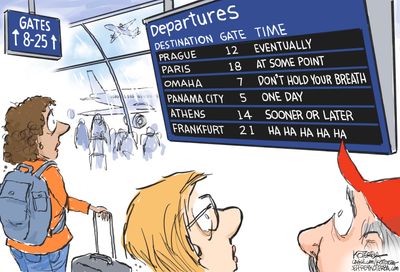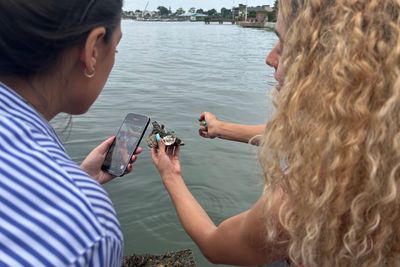by Shondiin Silversmith, Arizona Mirror
July 20, 2023
The Grand Canyon is Arizona’s most prominent natural formation that draws in millions of visitors annually with a landscape that holds significance to multiple Tribal Nations across the state. Still, the public lands surrounding the Grand Canyon have been the target for uranium mining for decades.
Growing up and living at the bottom of the Grand Canyon, Kambria Siyuja from the Havasupai Tribe said she’s witnessed her tribe fight against the threat of mining for generations.
“I grew up watching these people fight for so long, and my mother has grown up watching these people fight for so long,” Siyuja said, and she hopes that with her generation, it will finally come to an end so that they can have peace.
“That is our sacred grounds,” she said. “That is where we live.”
GET THE MORNING HEADLINES DELIVERED TO YOUR INBOXSUBSCRIBE
Siyuja was one of many Indigenous people to voice their support for protecting the Grand Canyon’s natural resources through the creation of a national monument.
The proposed Baaj Nwaavjo I’tah Kukveni Grand Canyon National Monument would protect about one million acres of the Tribal ancestral homelands outside Grand Canyon National Park.
Extracting minerals, particularly uranium, from sites near the Grand Canyon benefits only a few people for a short time, Colorado River Indian Tribes Chairwoman Amelia Flores said.
“This comes at the risk of contaminating the water, rocks, gravel, sands and soil of the Colorado River Basin,” Flores said, adding that “the benefit to a few does not outweigh the risk.”
To hear from the public concerning the monument, the Bureau of Land Management and the U.S. Forest Service hosted a public meeting in Flagstaff on July 18.
The meeting allowed the community to comment on managing the region’s public lands, including a proposal to designate existing public lands as a national monument.
Edmond Tilousi, the vice chairman of the Havasupai Tribe, noted that each Tribe holds its own traditional values for the Grand Canyon.
“As guardians of the Grand Canyon, we have a duty not only to our ancestors but also a duty to our children and future generations,” Tilousi said.
For decades, the Havasupai Tribe has opposed the operation of Pinyon Plain Mine, a uranium mine located about 10 miles south of the Grand Canyon.
The underground uranium mine sits on U.S. Forest Service land in the Kaibab National Forest in northern Arizona. The Havasupai Tribe, which lives at the bottom of the Grand Canyon, says the mine poses risks to its drinking water, natural wonders and sacred cultural sites.
“The threat of contaminating our water is real and current,” Tilousi said.
During public comments, Tilousi reiterated his tribe’s opposition to the mining and highlighted that the Grand Canyon is home to their tribe. It houses sacred sites, historic buildings, cultural teachings, medicine, land and water.
“Destinating these areas as a national monument will protect them from contamination, destruction, exploitation, and the other harmful effects of mining,” Tilousi said.
More than 100 people packed the ballroom at DoubleTree Flagstaff to hear from Tribal leaders, conservation advocates, and state and public officials on whether or not the Baaj Nwaavjo I’tah Kukveni Grand Canyon National Monument should be designated.
“We want to make sure that your voices are heard,” said Homer Wilkes, under secretary for natural resources and environment, U.S. Department of Agriculture. “I know this land is very important to you.”
The Paiute Indian Tribe of Utah Chairwoman Corrina Bow shared her support for the monument at the public meeting, addressing her comments to the federal officials stating that the land must be preserved and Indigenous people’s sacred areas and sites protected.
“I want to believe that you hear and listen to the voices of your Indigenous people, and you will help us to preserve and protect the lands that need to be protected,” Bow said.
Secretary of Interior Deb Haaland visited the proposed monument site in May to meet the tribal leaders, local elected officials, and community members to hear about their vision for conserving the natural and cultural resources in the greater Grand Canyon watershed.
The public meeting held in Flagstaff was the department’s response to the requests calling for the protection of the landscape as Baaj Nwaavjo I’tah Kukveni Grand Canyon National Monument, which the BLM and the U.S. Forest Service would manage.
The Grand Canyon is the ancestral homeland of multiple tribal nations in the Southwest, and tribes still rely on the canyon for natural and cultural resources that are significant and sacred to their communities.
The national monument designation would honor the tribes’ deep cultural ties to the Grand Canyon and protect the area by making permanent a temporary 20-year mining moratorium and enhancing the region’s cultural, natural, recreational and scientific resources.
The name of the proposed national monument comes from a mixture of the traditional Havasupai and Hopi languages.
Baaj Nwaavjo means “where tribes roam” for the Havasupai Tribe, and I’tah Kukveni means “our footprints” for the Hopi Tribe.
The Grand Canyon National Park shares boundaries with three federally recognized tribes, and 11 federally recognized tribes traditionally are associated with the area, according to the National Park Service.
A national monument can be created through legislation and presidential designation.
In April, state officials and tribal leaders of the Grand Canyon Tribal Coalition called on President Joe Biden to use his authority under the Antiquities Act of 1906 to designate the monument.
On July 12, Arizona Senators Mark Kelly and Kyrsten Sinema introduced The Baaj Nwaavjo I’tah Kukveni Grand Canyon National Monument Act to the Senate and Congressman Raúl Grijalva introduced it to the House, with support from Rep. Ruben Gallego.
The bill seeks to establish approximately 1,069,970 acres of federal lands currently managed by the Bureau of Land Management and the U.S. Forest Service in Arizona as a new Grand Canyon National Monument.
The legislation sets standards for the monument, including forming a tribal commission composed of one representative from each of the 12 federally recognized members of the Grand Canyon Associated Tribes to help oversee the development.
There was overwhelming support from community members, tribal leaders, conservation advocates, local businesses and local officials for creating the monument during the public meeting held in Flagstaff on July 18.
Navajo Nation President Buu Nygren could not attend the public meeting, but he provided a statement that included the tribe’s concerns about uranium mining and how Indigenous people have been at the forefront of the effort to protect the Grand Canyon since the beginning.
“The Grand Canyon is too important not to protect, yet hundreds of mining plants and several active uranium mines in the proposed mining area threaten to poison the landscape and destroy the sacred land,” Nygren said. “We know from first-hand experience the damage that can be caused by uranium mines contaminating our water and poisoning our animals and our children.”
Nygren highlighted how uranium mining during the Cold War devastated the Navajo people, and it caused many to get sick from tailings and the runoff that made it into Navajo communities.
“The majority of these mines remain open and unremedied, and they continue to threaten our people,” Nygren said, sharing how the Cove Day School in Red Valley had to shut its doors a few years ago because school officials found radioactive material.
Nygren said that protecting the Grand Canyon is the Navajo Nation’s primary motivation to join the efforts of fellow Arizona Tribal Nations to get the Baaj Nwaavjo I’tah Kukveni Grand Canyon National Monument designated.
“Tribes will continue to remain involved, no matter the decision of the federal government,” Nygren added. “This land has been our home for countless generations and will remain so for generations to come.”
During the public meeting, the monument was met with some opposition from state and county officials and ranchers who rely on the Arizona Strip, an extensive region on the north side of the Grand Canyon that borders Nevada and Utah.
“This proposal circumvents congressional authority, threatening the American public’s access and use of federal lands,” U.S. Rep. Paul Gosar, an Arizona Republican, said in a statement read at the public meeting. “Furthermore, the proposal was never coordinated with Mohave County officials whose community will be permanently changed by this designation.”
Gosar said that 50% of Arizona is designated federal land, and the state can not afford to lose any more of that land.
“Designating another 1.1 million acres as a national monument will further reduce private ownership and harm hardworking rural Americans in Mojave County,” Gosar said.
***UPDATE: This story has been updated to show that U.S. Rep. from Arizona Ruben Gallego also sponsored the monument bill.
Arizona Mirror is part of States Newsroom, a network of news bureaus supported by grants and a coalition of donors as a 501c(3) public charity. Arizona Mirror maintains editorial independence. Contact Editor Jim Small for questions: info@azmirror.com. Follow Arizona Mirror on Facebook and Twitter.




